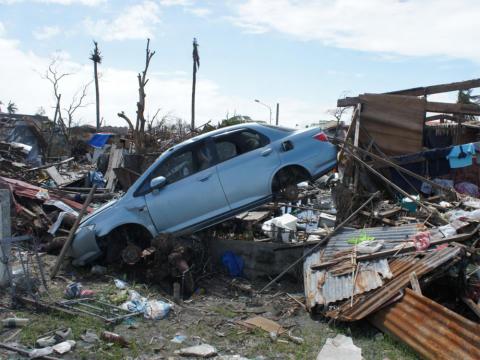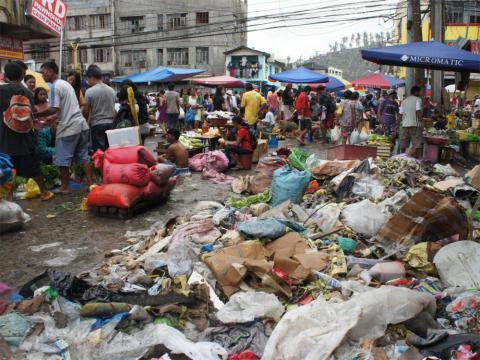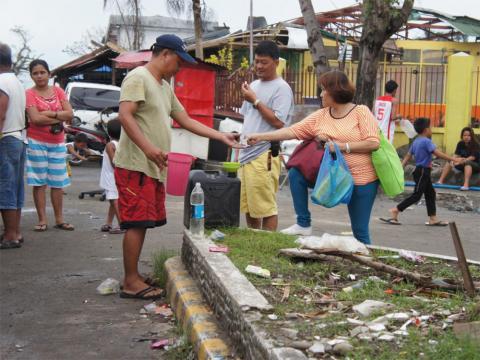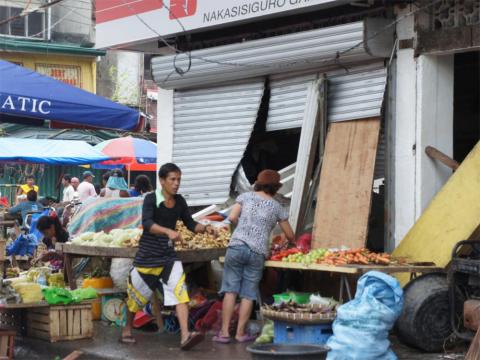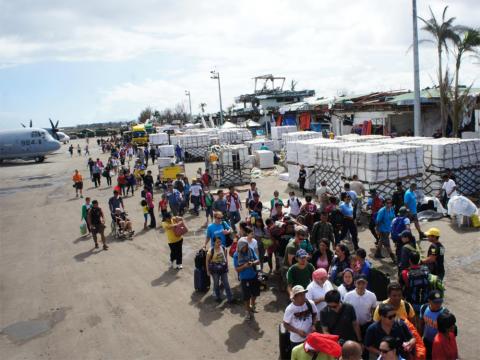Dear Friends
As of this writing, it was just three hours since I was back from Tacloban City. I took the 13:40 flight of the Air Asia.
The following are the impressions I gathered from the trip. My observations were limited to only the city center from November 23 to 24, 2013 and through a distant observer’s point of view. However, I was not able to capture the anguish, and despair of the aftermath.
- 1. On every part of the city, the damage of Typhoon Yolanda is still very much evident. Piles of debris are everywhere. Car and trucks tossed, electric posts broken, houses mangled and structures pinned down.
- 2. The City of Tacloban is now going under an early recovery phase. People have started building their shelter but not necessarily their own house. They are makeshift shelters made of pieces of timber, plywood, tin metal and all other pieces which they can pick up from the debris.
- 3. Cleaning the main roads has been intensive with all the bulldozers and trucks plus people getting paid under the cash for work donations.
- 4. Water service is back on certain side streets through small service pipes.
- 5. Power supply comes from electric generators. The Department of Energy Secretary pledged that power supply will begin to flow on December 24 but still residents are optimistic.
- 6. Criminality is on the minimum and there is a better sense of order. There is now a strong presence of the police and the military on almost every street corner. It was after a very scary period of looting, theft and there were even reports of murder and rape. During the typhoon, 500 prisoners from the provincial jail and 100 more at the city jail got out of prison, either set loose or escaped.
- 7. On Nov. 23, I saw a corpse on the street, but it was already covered with the Red Cross blanket. The following day, two more corpses were found on the beach. The stench is still very much in the air. Families are still very much shaken. I saw men collecting timber and fixing their shelters.
- 8. Evacuation centers were set at the city plaza and the sports center. There are more families moving out of the city through the C-130 cargo plane by the Philippine Airforce.
- 9. Humanitarian organizations are very much present. To name a few are UNICEF, World Food Programme, AeCid, Save the Children and those coming from Pakistan, Korea, Germany and USA. The government declared that there are 28 countries who responded to the disaster.
The Save the Children International
The response team of the SCI is well organized. They deployed a whole unit consisting of foreign and local staff coming from Australia, Singapore, Spain and their local counterparts. They rented a small hotel that has barely survived the disaster which has become their command center.
My coming to Tacloban is a personal initiative and unofficially that of the Save the Children. Somehow I managed to get myself into the hotel through the Filipino personnel and friends and had a good accommodation for two days and one night (while bending the protocols). The house supervisor, Ruben is in need of electricians, plumber, masons and engineers. Electric power at the hotel is supplied by a diesel powered generator but water has to be fetched from the hand pump across the street and brought to the toilets by each occupant. Everyone is busy with their own tasks.
A Local NGO: The Street Light
I came to know of this group from the Stoves Network Group, from Mr. Otto Formo. On several exchanges of email, he said they support the NGO through their movement at Norway. However, he could not connect me further to the people of the Street Light as he could not contact them either.
I found their office during my walk and was able to talk to Katrin, one of the social workers. Street Light serves street children. To date, according to Katrin, they have more than 100 children of ages 7 to 17 under their care and more than 23 personnel. Their office – dormitory was also ravaged by the waters. It is located at the beach front. We had a short meeting on the morning of November 24.
Katrin told her story during the Typhoon. She described about how the sea water rose up from the coastline rushing all the way past the entire first floor of their building and inwards. At 7:45 am, they had to quickly move up to the second floor of the main building. From the window, they saw how all their neighbours houses were quickly submerged under water. They were only able to go downstairs at 10:30 that morning.
The following day, they saw how the storm surged washed off everything around them. Eight bodies were found by their security guard, Michael at the beach by their building. Mr. Allan, their supervisor was able to keep safe the children under their care. He is now with them at the orphanage at Samal Island in Davao City. They all agree that the number of street children and orphans will rise because of this disaster.
A Pilot Project: A Food and Fuel Recovery Engine
I refer to this project an engine because it has several component parts and each part strictly connects to another to produce a common output plus several side outputs. The concept of this project was built upon that of permaculture. I randomly (or there may be a bigger theory over these) picked up a few and they are as follows: (1) turning the problems into solutions, (2) creating connectivity of the elements (3) every element serves more than one purpose, (4) and that they support and get support from one another in more than one connection.
After circulating a portfolio of possible projects in response to the disaster, a Senior Manager of the Save the Children, remarked that they are interested to integrate the projects into the recovery program but needs more details about the costs. Another field personnel of SCI in Tacloban remarked that such technologies are very much relevant more on the rural areas that in the cities. He anticipates that the recovery period may last up to three years and so there is still much to do. He observed that people are still very much shaken by the trauma. Piles of debris are everywhere and they do not know what to do with it. He would see people after cleaning would burn the wood piles to get rid of the trash. The debris on the roads is also hauled off by the bulldozers and trucks to a certain dumpsite. He agrees that such debris is a resource for fuel and food production. He anticipates that hunger is still very much around and will not easily pass away. Food aid is a temporary relief. November is a planting season and March is the normal harvest season. Therefore, food scarcity is expected until beyond March of next year.
Katrin and Michael of the Street Light also welcome a project that will teach new life skills to the children that they are helping. They would want that the children become better person and thus will bring the change to their families as soon as they are reintegrated. They will immediately discuss the matter with their chief of office, Mr. Allan.
Under the context that was described, I hereby propose a pilot project that will address a multilevel problem with a multilevel solution.
Relief to Early Recovery Period
| Problem Selected to be Addressed | Proposed Solution and Action Points | |
| An urgent need for food, shelter and income | Provision of ready to use tools and instruments. | Fabrication of the priority tools and instruments at Cebu with the manufacturing team and shipping it to Tacloban. |
| Absence of electrical supply. Repairs are on the way but may take several more months.Reconstruction of their shelters are on process painstakingly. | A wood gas generator and a set of metal and wood working tools. | Providing services of arc welding, and wood works, charging phones and batteries. |
| Piles of debris on the streets and home yards | Segregation and conversion to usable resource | Organizing transfer stations of each kind of material needed |
| Dependence on food aid. | A mobile shredding machine | Shredding the compostable materials for the container gardens |
| Anticipated hunger. The food aid will not last long. | Creation of food gardens with the use of minimum external inputs and maximum internal resources | Provision of container gardens in the immediate response |
| High cost of fuel for cooking: gas and wood charcoal | Conversion of the wood debris into fuel for cooking | Promotion of the biochar making stove: The SeaChar Model |
Transition Period: Late Recovery Period
| Lack of skills on appropriate technologies | Conduct of Skills Training Activities | Selection of participants and conduct of skills training |
| Absence of employment | Creation of livelihood enterprises with a regulated subsidy | Facilitating assistance from government agencies and other groups specializing on enterprise development. |
Concrete Steps
- 1. Fabricate five units of the Estufa Finca Stove by Sea Char. This stove model can be manufactured very quickly. It produces bio char and has available technical details about its construction and use. Other biochar making stoves will be fabricated soon after including my own holey roket stove in clay. We found no supply of bricks or clay yet.
- 2. Fabricate five units of Solar Drying In Wings designed by Jed Guinto
- 3. Fabricate five units of the garden tower. I understand this is already a commercially available product with a pending patent. I already sent an email to the authors of the design seeking consent that I use the design for this project. Im still waiting for their response.
- 4. Fabricate three prototypes of the rain water collector with portable water filter. Ship it to Tacloban and have it tested and evaluated by WASH practitioners on the field.
- 5. Ship off items 1-4 to Tacloban. Coordinate with the Street Light, Save the Children, and other organizations (possibly Habitat for Humanity, Child Fund and others) who are willing to commit to adopt or test the technologies and system with their clients.
- 5. Conduct a user’s training of the recipients by Jed Guinto.
- 6. The wood gas generator and the mobile shredding machine does not have definite donors yet.
- 6. Provide regular mentoring and coaching and solicit feedback.
- 7. Hold an evaluation and improve the designs.
- 8. Prepare for the second round of the manufacture and distribution.
To conclude, as this project mission is on my own initiative. What I could only offer is new set of concepts and putting the concepts into concrete actions and innovations in the theme of permaculture and appropriate technology. I hope that bigger organizations will adopt the lessons learned from this mission and get it on the mainstream. Likewise, I also anticipate learning more from fellow development workers from this episode.
I would like to thank those that donated the funds that made this trip possible. I would also like to thank Lou, Melanie, Ruben and Julius of the Save the Children for the two day accommodation in the hotel. And more than these, I thank those who are in the belief and confidence of what I can do for my fellow Filipinos in distress. To all the prayers and encouragement, I thank you.
As more pledges are still on hold pending the submission of this report, I hereby welcome all your remarks and conversations.
A separate photo gallery will be sent off shortly
A pleasant day to you all.
Jed Guinto
Safely back in Manila
Buty treningowe do biegania w terenie

